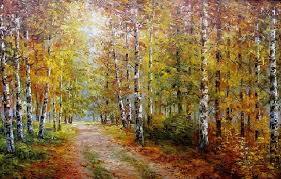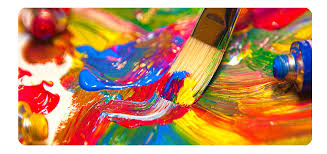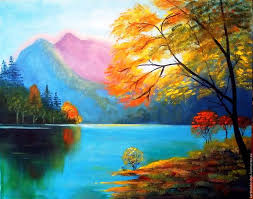LENINGRAD SCHOOL OF PAINTING (part 2)
 In the narrow, literal sense, the Leningrad school usually means the Leningrad Institute of Painting, Sculpture and Architecture named after I.E. Repin (LIZHSA) from 1932 until the early 1990s, its traditions, teachers, pupils and their artistic heritage.
In the narrow, literal sense, the Leningrad school usually means the Leningrad Institute of Painting, Sculpture and Architecture named after I.E. Repin (LIZHSA) from 1932 until the early 1990s, its traditions, teachers, pupils and their artistic heritage.
In a broader sense, the concept of “Leningrad school”, in addition to the LIJSA named after I. E. Repin, includes a group of institutions closely associated with the institute of higher and secondary educational institutions, as well as the Leningrad Union of Artists from its inception in 1932 until the beginning of the 90s. x years.
And yet, figuratively speaking, the Leningrad school is, as history has shown, first of all a unique human alloy derived from the richest breed, with a minimum amount of extraneous “impurities” carefully collected throughout the country, in the Russian province, outback passed further through the world’s most advanced “enrichment factory” and cast in the furnace of the era.
Representatives of the Leningrad school of painting include about 1,200 artists, of whom about 400 names in different years and in different genres defined her “face”. Her pupils in 1930-50 were E.P. Antipova, T.K. Afonina, E.V. Baykova, N.N. Baskakov, P.P. Belousov, D.V. Belyaev, and O. B. Bogaevskaya, I. M. Varichev, A. I. Vasiliev, I. P. Veselkin, R. I. Vovkushevsky, N. N. Galakhov, V. V. Golubev, E. K. Gorokhova, G. P. Egoshin, A. G. Eremin, V.F. Zagonek, M.A. Zubreeva, M.A. Kaneev, E.V. Kozlov, M.K. Kopytseva, B.V. Korneev, A.P. Korovyakov, E.M. Kostenko, Y. I. Krestovsky, B. M. Lavrenko, A. I. Laktionov, O. L. Lomakin, D. I. Mayevsky, E. E. Moiseenko, A. A. Mylnikov, M. D. Natarevich, S. G. Nevelshtein, A. A. Nenartovich, Yu. M. Neprintsev, D. G. Obozne co., V.I. Ovchinnikov, L.N. Orekhov, V.M. Oreshnikov, S.I. Osipov, V.M. Petrov-Maslakov, Yu. S. Podlyasky, N.M. Pozdneev, A. Pushnin, V.I. Reichet, L.A. Ronchevskaya, S.A. Rotnitsky, L.A. Rusov, G.A. Savinov, A.M. Semenov, A.N. Semenov, V.A. Serov, E. P. Skuin, A. I. Sokolov, V. V. Sokolov, E. I. Tabakova, V. K. Teterin, N. E. Timkov, V. F. Tokarev, M. P. Trufanov, Yu. N. Tulin, V. I. Tyulenev, B. S. Ugarov, L. A. Fokin, P. T. Fomin, B. D. Harchenko, Yu. D. Khukhrov, V. F. Chekalov, B. I. Shamanov, A.V. Schmidt, N.P. Steinmiller, L.S. Yazgur and many other famous or, on the contrary, half-forgotten artists.
From the first steps, the Leningrad school was distinguished by the spirit of democracy in the true sense of the word. Among her priorities was not servicing the elite of the metropolitan society; she did not select candidates by place of birth or affiliation with wealthy strata. On the contrary, it attracted and encouraged to master the art of painting gifted people from all walks of life and especially from the Russian province, from workers and peasant families, from the former “social lower classes” of society, for whom the road to such an education was often closed before the revolution.
Her students brought into the art a sense of authenticity, moral purity, faith in man and a passionate desire to change the world for the better. The life of the Volga, the Don, the White Sea, their way of life, agitated by the civil war, the romance of the first years of the revolution and the enthusiasm of the first five-year plans, the roads of war and the brotherhood of soldiers remained the most expensive and important impressions for many of them. Having traveled with the country through the difficult path of the trials that fell to their lot, they embodied in their works the experience of the people with their troubles, pain, selfless struggle and the joy of common victories, with their faith in the triumph of good and justice unshakable.
The formation of the Leningrad school was preceded in the second half of the 1920s and early 1930s by an intense ideological struggle of various groups of artists who strove to affirm the priority of their own views on the forms and development paths of young Soviet art, to master key posts in cultural institutions, and to gain favor , favor, support of the authorities.
It is well known that the crisis of the “left” art, which flourished in the first post-revolutionary years, gave an additional urgency to this struggle. This applies equally to the “left” associations of artists and currents in painting, as well as to the “left” experimenters in art education.
At the turn of the 1920s and 1930s, many avant-garde trends that emerged back in the 1910s and experienced prosperity in the post-revolutionary period, “took off”, lost their former novelty, as if trying to return to the traditional system of pictorial and plastic images. So, for example, what happened to A. A. Osmerkin and other artists of The Jack of Diamonds. At the beginning of the 1930s, K. S. Malevich returned to subject art.
Of course, there is a temptation to explain such a turn by state pressure and the forced desire of avant-garde leaders to reconcile their work with traditional art. But how then to explain similar trends in European art?




